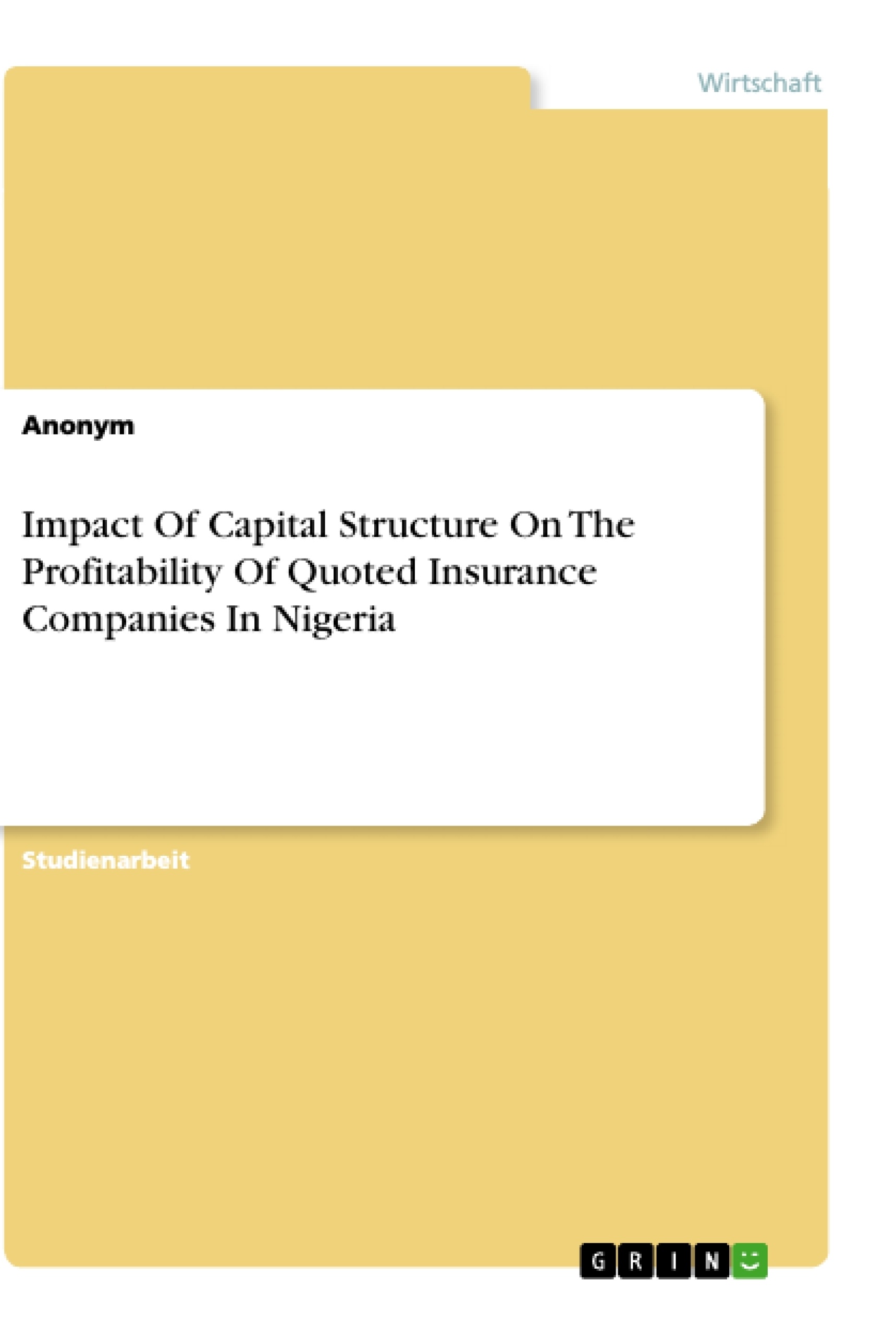The study examines the impact of capital structure on the profitability of Nigerian quoted insurance companies with specific emphasis on AIICO Plc which is one of the 15 quoted insurance companies in Nigeria. The scope covers the period of ten (10) years (2010 to 2020). AIICO PLC was selected based on the criteria of data availability.
The study assists financial managers of firms to determine the proportion of equity capital and debt capital (capital structure) to obtain the debt financing mix that will optimize the value of the firm. This study, therefore, has contributed to the literature by examining capital structure and profitability of Nigerian quoted insurance companies. The study aids in the understanding of the impact of capital structure on insurance profitability. This has helped us to understand the impact of capital structure in profitability of Nigeria quoted insurance companies.
The outcome from this study will help decisions on capital structure and allow the policy makers in formulating informed policies on capital structure and also to measure the implications of such policies on the operations of quoted insurance companies. This will go a long way in helping investors in deciding whether to pull out their share in pursuance of capital gains or preserve their stake in a corporation. The study will contribute to existing body of knowledge by investigating capital structure and profitability of Nigerian quoted insurance companies.
Inhaltsverzeichnis
- KAPITEL EINS. EINFÜHRUNG
- 1.1 Hintergrund der Studie.
- 1.2 Problemstellung.
- 1.3 Formulierung der Forschungsfragen.
- 1.4 Ziele der Studie.
- 1.5 Formulierung der Hypothesen.
- 1.6 Bedeutung der Studie.
- 1.7 Umfang der Studie.
- 1.8 Einschränkungen der Studie.
- 1.9 Operative Definition der Begriffe.
- KAPITEL ZWEI. LITERATURÜBERSICHT
- 2.1 Einleitung.
- 2.2 Konzept der Rentabilität.
- 2.3 Konzept der Kapitalstruktur.
- 2.4 Literaturübersicht zu früheren Studien.
- 2.5 Theoretischer Rahmen.
- 2.6 Wissenslücke.
- KAPITEL DREI. FORSCHUNGSMETHODIK
- 3.1 Einleitung.
- 3.2 Forschungsdesign.
- 3.3 Grundgesamtheit der Studie.
- 3.4 Datenquellen.
- 3.5 Methode der Datenerhebung.
- 3.6 Stichprobengröße.
- 3.7 Stichprobenverfahren.
- 3.8 Variablenmessung.
- 3.9 Modell Spezifikation.
- 3.10 Techniken zur Datenanalyse.
- 3.11 Begründung der verwendeten Methoden.
- KAPITEL VIER. DATENPRESENTATION UND ANALYSE
- 4.1 Einleitung.
- 4.2 Datenpräsentation und Analyse.
- 4.3 Hypothesentest.
- 4.4 Diskussion der Ergebnisse.
- KAPITEL FÜNF. ZUSAMMENFASSUNG, SCHLUSSFOLGERUNGEN UND EMPFEHLUNGEN
- 5.1 Zusammenfassung.
- 5.2 Schlussfolgerungen.
- 5.3 Empfehlungen.
- 5.4 Beitrag zum Wissensstand.
- 5.5 Empfehlungen für weitere Studien.
Zielsetzung und Themenschwerpunkte
Diese Studie untersucht den Einfluss der Kapitalstruktur auf die Rentabilität von börsennotierten Versicherungsunternehmen in Nigeria. Sie zielt darauf ab, die Beziehung zwischen Kapitalstruktur und Rentabilität zu analysieren und die Faktoren zu identifizieren, die diese Beziehung beeinflussen.
- Die Auswirkungen von Schulden auf die Rentabilität von Versicherungsunternehmen.
- Die Rolle der Kapitalstruktur bei der Erreichung der Unternehmensziele.
- Die Relevanz von Finanzierungsstrategien für die Profitabilität von Versicherungsunternehmen.
- Die Bedeutung von Kapitalstruktur und Rentabilität im Kontext der nigerianischen Versicherungsbranche.
Zusammenfassung der Kapitel
Kapitel 1 liefert eine Einführung in das Thema, indem es den Hintergrund der Studie, die Problemstellung, die Forschungsfragen, die Ziele, die Hypothesen, die Bedeutung, den Umfang, die Einschränkungen und die Definitionen der verwendeten Begriffe darlegt.
Kapitel 2 befasst sich mit der Literaturübersicht zum Thema Kapitalstruktur und Rentabilität. Es beleuchtet das Konzept der Rentabilität und der Kapitalstruktur, untersucht frühere Studien und präsentiert einen theoretischen Rahmen für die Analyse.
Kapitel 3 beschreibt die Forschungsmethodik, einschließlich des Forschungsdesigns, der Stichprobenziehung, der Datenquellen, der Datenerhebungsmethoden, der Datenanalyse und der Begründung der verwendeten Methoden.
Kapitel 4 präsentiert die Ergebnisse der Datenanalyse, einschließlich der Datenpräsentation, der Hypothesentests und einer Diskussion der Ergebnisse.
Schlüsselwörter
Die Studie konzentriert sich auf die Schlüsselbegriffe Kapitalstruktur, Rentabilität, Versicherungsunternehmen, Nigeria, Finanzierungsstrategien, Finanzmärkte und Unternehmensführung.
- Quote paper
- Anonym (Author), 2020, Impact Of Capital Structure On The Profitability Of Quoted Insurance Companies In Nigeria, Munich, GRIN Verlag, https://www.grin.com/document/1154629



